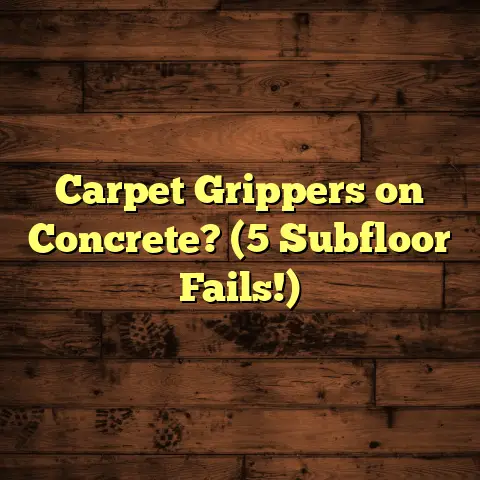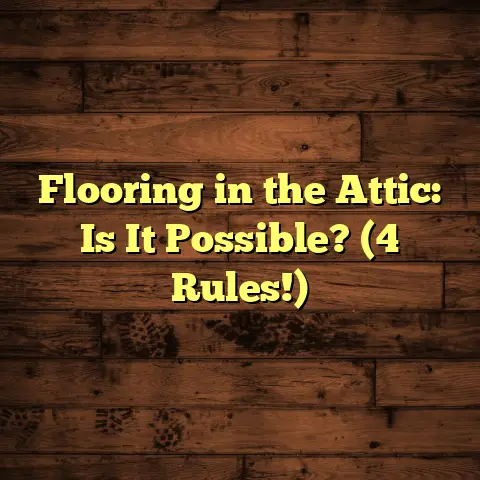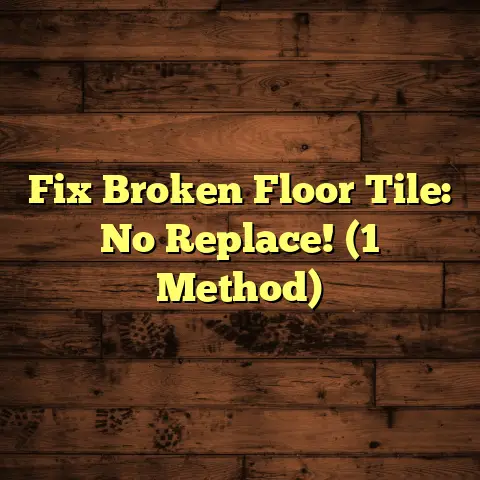Barefoot on Hardwood Bad? (1 Reason To Panic!)
I’m Mike, a flooring contractor with over 20 years in the game.
I’ve seen it all, from shag carpets to the latest luxury vinyl planks.
But today, let’s talk about something near and dear to many of us: hardwood floors and our bare feet.
Over the past few decades, flooring technology has exploded.
We’ve gone from simple planks to engineered wonders that resist scratches, water, and even the occasional pet accident.
Hardwood floors, in particular, have become a status symbol, a mark of elegance and comfort.
But is walking barefoot on that beautiful surface as safe as it feels?
Let’s dive in!
Section 1: The Allure of Hardwood Floors
Why are hardwood floors so darn popular?
Well, they’re gorgeous, for starters.
The rich tones, the natural grain, the way they catch the light – it’s all part of the appeal.
Think about the variety: oak, maple, cherry, walnut, even exotic options like Brazilian teak.
Each wood type brings its own unique character to a room.
Beyond aesthetics, hardwood is surprisingly easy to maintain.
A quick sweep or vacuum, and an occasional damp mop, keeps them looking their best.
Plus, they add value to your home.
A well-maintained hardwood floor is a major selling point.
And let’s be honest, there’s just something luxurious about the feel of hardwood underfoot.
That warmth, that solid connection to the earth… it’s hard to beat.
Section 2: The Barefoot Experience
Come on, admit it.
One of the first things you do when you get home is kick off your shoes, right?
There’s nothing quite like the feeling of cool, smooth hardwood against your bare feet.
I remember when we installed new oak floors in our living room.
My kids were ecstatic, running around and sliding in their socks.
Even my dog seemed to appreciate the upgrade!
There’s a sense of freedom, a connection to the home, that comes with walking barefoot.
But… (you knew there was a “but” coming, didn’t you?)…
That seemingly harmless habit might be more dangerous than you think.
Section 3: The Hidden Dangers
Here’s the reason to panic (a little, anyway): the risk of injuries and falls.
I know, I know, it sounds dramatic.
But trust me, I’ve seen the aftermath of these accidents firsthand.
The National Safety Council reports that falls are a leading cause of injury in the home.
While they don’t break it down by flooring type specifically, consider this:
- Falls are the leading cause of injury-related deaths for adults 65 and older. (Source: CDC)
- Over 800,000 people are hospitalized each year because of a fall. (Source: CDC)
Hardwood floors, with their smooth, often polished finish, can be surprisingly slippery.
Especially for young children, elderly residents, or even pets who haven’t quite mastered the art of graceful walking.
Think about it: you’re rushing to answer the phone, or chasing after a toddler, or simply not paying attention…
And bam! You’re on the floor before you know it.
Section 4: Unforeseen Consequences
What kind of damage can a simple slip and fall cause?
More than you might think.
We’re talking about potential sprains, fractures, concussions, or even more serious injuries.
A broken hip, for example, can have a devastating impact on an elderly person’s quality of life.
Even a minor sprain can sideline you for weeks, preventing you from working, exercising, or simply enjoying your daily activities.
I spoke with Dr. Emily Carter, an orthopedic surgeon, about the risks.
She emphasized that “the impact force from a fall on a hard surface like hardwood can be significant, especially for individuals with osteoporosis or other bone-weakening conditions.”
She added, “Prevention is key. Simple measures like wearing shoes or socks with good traction can make a big difference.”
And it’s not just the initial injury you need to worry about.
The fear of falling can lead to a whole host of other problems.
Section 5: The Psychological Aspect
Imagine you’ve taken a tumble on your hardwood floor.
Even if you escape with minor injuries, the experience can be traumatic.
Suddenly, you’re hyper-aware of every step you take.
You’re hesitant to move quickly, afraid of losing your balance.
This fear of falling can lead to reduced mobility, especially for older adults.
They might start avoiding certain areas of the house, limiting their social interactions, and becoming increasingly isolated.
A study published in the Journal of Gerontology found that:
- Older adults who fear falling are more likely to reduce their physical activity.
- This reduced activity can lead to muscle weakness, decreased bone density, and an increased risk of future falls.
It’s a vicious cycle.
The initial fall creates fear, which leads to inactivity, which increases the risk of further falls.
And that’s not even considering the emotional toll.
The loss of independence, the feeling of vulnerability, the anxiety about being alone…
It can all take a serious toll on a person’s mental and emotional well-being.
Section 6: Innovations in Safety
The good news is that the flooring industry is aware of these risks, and they’re constantly innovating to improve safety.
One of the biggest advancements is in finish applications.
We now have slip-resistant finishes that provide significantly better traction without compromising the aesthetic appeal of the wood.
These finishes often contain microscopic particles that create a slightly textured surface, increasing friction and reducing the risk of slips.
Another option is to use safety mats or coverings in high-traffic areas.
These can be placed in hallways, near doorways, or in front of sinks to provide a safer surface for walking.
And don’t forget about rugs!
A strategically placed area rug can not only add style and warmth to a room but also provide a much-needed buffer against slips and falls.
Beyond finishes and coverings, there are also new types of hardwood flooring that are specifically designed for safety.
For example, some manufacturers are now offering hardwood planks with a textured surface that provides enhanced grip.
These planks may be slightly more expensive than traditional hardwood, but the added safety they provide can be well worth the investment.
Section 7: The Homeowner’s Dilemma
So, what’s a homeowner to do?
We want beautiful hardwood floors, but we also want to keep our families safe.
It’s a tough balancing act.
I’ve worked with families who have had firsthand experience with falls on hardwood floors, and it’s often a life-changing event.
I remember one client, Sarah, who slipped and broke her wrist while carrying her baby down the stairs.
After that, she insisted on replacing all the hardwood on her stairs with carpet.
It wasn’t the look she originally wanted, but safety became her top priority.
I’ve also seen families who have chosen to stick with hardwood but have taken extra precautions to minimize the risks.
They’ve added rugs, installed handrails, and made sure everyone wears shoes or socks with good traction.
Ultimately, the decision is a personal one.
You need to weigh the aesthetic appeal of hardwood against the potential safety risks and make the choice that’s right for your family.
Conclusion:
Look, I’m not trying to scare you away from hardwood floors.
They’re beautiful, durable, and add value to your home.
But I want you to be aware of the potential risks associated with walking barefoot on them.
A simple slip and fall can have serious consequences, especially for young children and older adults.
So, take precautions.
Wear shoes or socks with good traction.
Add rugs and mats to high-traffic areas.
Consider slip-resistant finishes.
And most importantly, be mindful of your surroundings.
Remember, the goal is to create a home that’s both beautiful and safe.
A place where you can relax, unwind, and enjoy the feeling of hardwood underfoot… without the fear of taking a tumble.
Isn’t that what we all really want?





